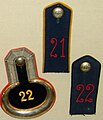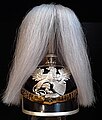3. Badisches Dragoon Regiment "Prinz Karl" No. 22
The third Badische Dragoon Regiment "Prince Carl" Nr. 22 was a cavalry joined the Grand Ducal Baden army and since 1871 part of the Prussian army .
history
On January 6, 1850 (Foundation Day), the establishment of a third cavalry regiment was ordered in place of the dissolved regiment of the Badische Garde du Corps and Mannheim was designated as a garrison . On January 10, 1853, the association was formed to form the 3rd Dragoons Regiment and with the appointment of Prince Karl von Baden as head of the regiment , on November 19, 1859, it was named the 3rd Dragoons Regiment "Prince Karl" . In 1864 the association moved into garrison in Durlach . After the military convention with Prussia , the association was named 3rd Badisches Dragoon Regiment "Prince Karl" No. 22 on July 1, 1871 and was subordinated to the newly formed 29th Cavalry Brigade . In 1890 the regiment moved to Mulhouse in Alsace.
German war
As part of the VIII Federal Army Corps , the regiment took part in the battles near Hundheim , Werbach and Gerchsheim in 1866 during the war against Prussia .
Franco-German War
Immediately after the outbreak of war, a detachment of the regiment under the command of Captain Count Zeppelin undertook a long-distance patrol to France , which became known as the surprise of the gate guard in Lauterburg. This investigation gave the army command the important information that no French troops were deployed in Lower Alsace. Afterwards participation in the siege of Strasbourg in September 1870. Afterwards patrol and security services in the rear area until the end of the war.
First World War
After the mobilization in August 1914, the march to the west followed with reconnaissance against the French fortress Belfort , followed by patrol services in French Lorraine . In March 1915, the regimental association was disbanded and the 1st and 2nd squadrons of the 115th Infantry Division and the 3rd and 4th squadrons of the 111th Infantry Division were assigned. There the cavalry was used in the order and security service of the rear divisions. In 1916 the 1st and 2nd Squadrons were relocated to the eastern theater of war . The 1st Squadron remained in Lithuania , while the 2nd Squadron was subordinated to the Austro-Hungarian High Command. She fought in Galicia and took part in the campaign against Romania . The 3rd and 4th Squadrons remained in the west and were used, among other things, in the Battle of the Somme .
In 1918 the regiment in the west was reunited, trained as infantry after the horses were surrendered and used in defensive battles in Flanders , the Argonne and along the Meuse .
Whereabouts
After the armistice of Compiègne and the return home, the regiment was demobilized and dissolved on May 31, 1919 in Sinsheim . This did not affect the 2nd Squadron , which joined the "Voluntary State Rifle Corps" and was deployed to fight the unrest in Berlin , Bremen , Düsseldorf , Westphalia and Magdeburg .
The unit was then integrated into the 18th Cavalry Regiment of the Reichswehr in Ludwigsburg as 3rd Squadron and carried on the tradition of the former Dragoons Regiment. In the Wehrmacht , the 8th Panzer Regiment in Böblingen continued the tradition. The “Association of Former Prince Karl Dragoons” also maintained the traditions.
Commanders
| Rank | Surname | date |
|---|---|---|
| Lieutenant colonel | Theodor von Glaubitz and Altengabel | January 10, 1850 to December 15, 1855 |
| Colonel | Ludwig Schuler | December 17, 1855 to July 4, 1856 |
| Colonel | Karl von Wechmar | July 5, 1856 to June 19, 1866 |
| Colonel | Udo from La Roche-Starkenfels | June 20, 1866 to May 19, 1867 |
| Lieutenant colonel | Georg Knittel | May 20, 1867 to July 18, 1869 |
| Lieutenant Colonel / Colonel | Wilhelm Dietrich of Gemmingen | June 19, 1869 to January 1, 1876 |
| Colonel | Alfred von Kaphengst | January 2, 1876 to October 15, 1879 |
| Lieutenant Colonel / Colonel | Adolf von der Lühe | October 16, 1879 to December 10, 1886 |
| Colonel | Friedrich von Merckel | December 11, 1886 to March 21, 1889 |
| Lieutenant Colonel / Colonel | Hans von Tresckow | March 22, 1889 to September 16, 1893 |
| Lieutenant Colonel / Colonel | Ernst Brinckmann | June 17, 1893 to November 17, 1897 |
| Lieutenant colonel | Kurt von Frankenberg and Ludwigsdorf | November 18, 1897 to March 17, 1899 |
| Colonel | Franz Weisbrodt | March 18, 1899 to January 17, 1901 |
| Lieutenant Colonel / Colonel | Alexander Torgany | January 18, 1901 to May 20, 1906 |
| Colonel | Fritz von Unger | May 21, 1906 to March 2, 1908 |
| Lieutenant colonel | Rudolf Rusche | March 3 to July 20, 1908 (in charge of the tour) |
| Lieutenant Colonel / Colonel | Rudolf Rusche | July 21, 1908 to July 19, 1912 |
| Lieutenant Colonel / Colonel | Hermann von Witzleben | July 20, 1912 to July 16, 1917 |
| Lieutenant colonel | Albert von Nettelbladt | July 17, 1917 to January 22, 1919 |
| major | Konrad von Stotzingen | February 19 to May 31, 1919 |
uniform
The dragoons wore a cornflower blue tunic and charcoal gray trousers. The tunic was equipped with Swedish lapels and ponceau-red advances .
The so-called badge color of the regiment was black. The cuffs, the stand-up collar, the epaulette fields and passers-by were of this color . The buttons and fittings were made of nickel silver. A white bandolier with a black cartridge ran from the left shoulder to the right hip . The bandolier and cartridge were not worn with the evening suit and formal suit. The helmet was decorated with the Baden griffin and scale chains. For the parade a white (for the musicians a red) horsehair bush was put on instead of the tip. The national cockade was yellow-red, as was the team's lance flag. The non-commissioned officers' lance flag was yellow with a red Baden griffin.
According to AOK of February 14, 1907, the field gray uniform M 1910 was introduced for field service from 1909/10. In this uniform, the straps and boots were natural brown, the helmet was covered by a reed-colored cover. The bandolier and cartridge were no longer worn.
literature
- Georg Bahls: The 3rd Baden Dragoon Regiment Prince Karl No. 22 on the basis of the printed regimental histories and unpublished sources from the prewar period as well as the regiment's official war files. ( = German deed in World War 1914/1918. Volume 16). Bernard & Graefe, Berlin 1934 ( digitized version from the Württemberg State Library ).
- Jürgen Kraus: The German Army in World War I: Uniforms and Equipment. 1914 to 1918. Verlag Militaria, Vienna 2004, (= catalogs of the Bavarian Army Museum, 2), ISBN 3-9501642-5-1 .
- Hugo FW Schulz: The Prussian Cavalry Regiments 1913/1914. Podzun-Pallas Verlag, Friedberg 1985, licensed edition Weltbild Verlag, Augsburg 1992, ISBN 3-89350-343-9 .
Individual evidence
- ^ Military History Research Office (ed.), Hans-Joachim Harder : Military History Handbook Baden-Württemberg. Verlag W. Kohlhammer, Stuttgart 1987, ISBN 3-17-009856-X , pp. 108-109.
- ^ Günter Wegmann (Ed.), Günter Wegner: Formation history and staffing of the German armed forces 1815-1990. Part 1: Occupation of the German armies 1815–1939. Volume 3: The occupation of the active regiments, battalions and departments from the foundation or list up to August 26, 1939. Biblio Verlag, Osnabrück 1993, ISBN 3-7648-2413-1 , pp. 84–85.




